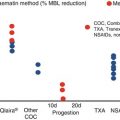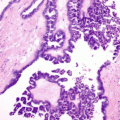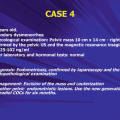Oestroprogestogens
Aspirin
Gonadotrophins
Nitric oxide
Clomiphene citrate
Prednisone
Aromatase inhibitors
Plasmapheresis
GnRH agonists
Pentoxifylline-tocopherol
GnRH antagonists
Apoptotic inhibitor
Recombinant LH
Sphyngosine-1-phosphate
Recombinant growth hormone
DHEA
Natural cycle or cycle modified with oestroprogestagens represents the method of choice nowadays with 5–15 % of success resulting in pregnancy.
Loutradis et al. [8] found that low-dose human chorionic gonadotrophin in the first days of the ovarian stimulation had promising results in grade I POI.
Oocytes of women with diminished ovarian reserve are prone to a high rate of meiosis errors leading to a high rate of aneuploidy [9].
It was found that GnRH does not improve the successful ovulation induction with exogenous gonadotrophins. van Kesteren et al. [10] gave 4 weeks intranasal buserelin 1,000 ug daily or placebo, the 3-week human menopausal gonadotrophin in weekly augmented dose, but no difference in pregnancy rate was found. Gonadotrophin therapy carries a theoretical risk for exacerbating autoimmune POI.
Dehydroepiandrosterone (DHEA) is converted to oestradiol which suppresses FSH. Increasing of the testosterone production by the very early follicles stimulates androgen receptors allowing more preantral follicles to progress to more mature antral follicles [11].
In a case of failure of all mentioned protocols, some new therapeutical options can be performed.
14.5 Modern Technique for Ovulation Induction in POI
Donor oocytes can be advised to a woman with POI failing to conceive under oestroprogestogens previously and with well-prepared endometrium (Table 14.2).
Table 14.2
Other approaches to pregnancy in POI
Donor oocyte |
Embryo freezing |
Freezing of mature eggs |
Cryopreservation and tissue transplantation |
Vitrification |
In vitro activation |
Cryopreservation is freezing of tissue or cells in order to preserve for the future [12]. Methods can be slow freezing or vitrification (ultrarapid freezing).
Vitrification is a process of converting something into a glasslike solid that is free of crystal form. By adding a cryoprotectant, water can be cooled until it hardens like glass without crystal formatting. It is important because ice crystal formate can damage frozen embryo.
Ovarian tissue cryopreservation can be performed in prepubertal girls at risk for POI, and this procedure is as feasible and safe as comparable operative procedures in children [13].
Ovary transplantation can be done with fresh cortical ovarian tissue transplantation, frozen cortical ovarian transplantation or whole ovary transplantation.
In vitro activation (IVA) requires ovaries to be removed from a woman, treated outside the body, then reimplanted near the fallopian tubes. The woman is then treated with hormones to stimulate the growth of specialized structures in ovaries called follin. These women still have very tiny primordial, primary and secondary follicles and may be treatable.
PTEN is a gene that encodes for a protein involved in several critical signalling pathways inside cells including metabolism, growth and survival. It controls follicular growth. Blocking the activity of PTEN in mouse and human ovary was enough to stir dominant follicles into growth and production of mature eggs. Ovaries can be treated with substances modulating the PTEN pathway.
Stay updated, free articles. Join our Telegram channel

Full access? Get Clinical Tree







